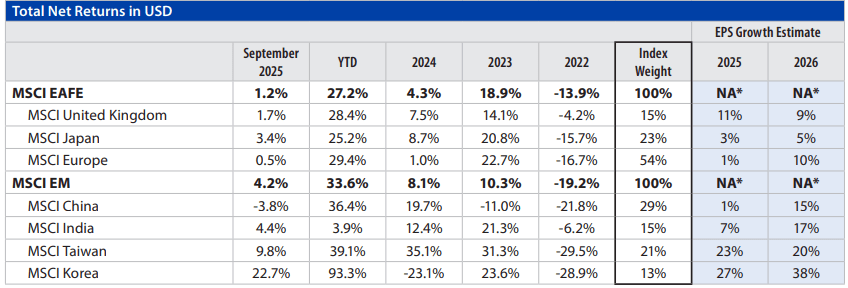International Equities Monthly
- After a sharp decline in the first half of the year, the U.S. dollar has stabilized. Its next move is uncertain, but we believe that it is unlikely to resume the secular rally that it has persisted for much of the past 15 years.
- The rally in gold suggests that foreign central banks and investors are seeking alternatives to the dollar. According to the IMF, the dollar’s share of global foreign-exchange reserves has declined to around 57-58% in recent quarters, the lowest level in about 30 years. However, the New York Federal Reserve finds that much of the decline is concentrated among a small number of countries. While the desire to reduce dollar exposure is real, the process will likely be gradual given the limited availability of viable alternatives.
- In the first half of this year, fund flow data showed that foreign investors had been reallocating away from U.S. equities, likely a response to dollar weakness, which eroded local currency returns. In addition, concerns over U.S. market concentration, elevated valuations, and rising political and policy risks under the second Trump presidency added to investor caution. Flows in the second half have been more mixed as the dollar has found support.
- In the near term, the dollar’s direction will largely hinge on the Fed, particularly, the pace and number of future rate cuts. While earlier data suggested economic resilience and fewer cuts, alternative data indicators have been more mixed since the government shutdown.
- Over the longer term, structural forces are likely to restrain the dollar. High valuations, widening trade and fiscal deficits, and uncertainty surrounding U.S. fiscal and trade policy are causing foreign investors to employ a greater degree of currency hedging and to seek alternatives.
- Taken together, while the near-term outlook is less certain, the fundamentals point to longer-term vulnerability for the dollar, supporting the case for U.S.-based investors to maintain strategic allocations in international equities.

- We maintain a neutral strategic allocation to developed international equities. Traditional headwinds such as currency volatility and expanding valuation discounts are easing and may even become tailwinds. As these pressures subside, developed international markets are better positioned to compete with U.S. equities, with earnings and dividends expected to be the primary drivers of returns.
- Europe’s economy remains constrained, with 3Q GDP growing just 0.2% Q/Q annualized. Earnings season was slightly positive, as weak revenue growth was offset by cost-cutting. In 2026, earnings are forecast to grow in the high single digits after three years of stagnation. Promisingly, strong price and earnings performance from European banks signals improving economic health, and Germany’s suspension of its debt brake opens the door to fiscal stimulus.
- Near-term conditions for the U.K. appear more fragile, as commodity-linked sectors continue to face headwinds. However, given low expectations and depressed valuations, U.K. equities have upside potential heading into 2026.
- Japan’s markets have so far shrugged off political noise and signs of slower growth. That could change if the Bank of Japan (BOJ) turns more hawkish and raises rates to rein in nagging inflation. The BOJ is currently expected to hike once at the end of the year, but we believe slowing growth and negative real wage growth will keep it from adopting a more aggressive stance. If we are wrong, higher rates could strengthen the yen, offsetting one of corporate Japan’s competitive advantages.
- Performance for the MSCI EAFE index has diverged significantly from that of the S&P 500. Performance for the MSCI EAFE has been driven by the Value style. In fact, the MSCI EAFE Value index has meaningfully outperformed the S&P 500 over the past one and three years and has matched it over five years. S&P 500 performance has been dominated by the Growth style. Differentiated return streams are generally seen as a positive from an asset-allocation standpoint.
- Looking ahead, we believe developed international equities offer long-term advantages - including lower valuations, higher dividend yields, potential currency tailwinds, and less reliance on a narrow set of U.S. mega-cap stocks.

- We increased our exposure to emerging market (EM) equities to a slight overweight, reflecting an attractive risk/reward profile relative to U.S. equities.
- As in international developed markets, currency and valuation headwinds are easing. These factors are now less likely to detract from returns and could even become supportive. With these headwinds subsiding, earnings and dividends should increasingly drive EM performance, putting them on more even footing with U.S. stock return drivers.
- A weaker dollar and Fed rate cuts should support EM assets by giving local policymakers more room to stimulate growth and attract capital flows. Historically, EM equities have outperformed both U.S. and developed international stocks during Fed easing cycles that did not coincide with recessions.
- EMs also provide significant exposure to Technology and AI, with the sector now the largest weight in the MSCI EM index. The index includes major players in the global AI semiconductor supply chain. And investors gain exposure to China’s differentiated approach to AI (open source), which may accelerate adoption and broaden investment opportunities.
- The recent 10-percentage-point tariff cut on Chinese goods is a meaningful positive for China. Many of China’s past tech darlings, like Alibaba, Tencent, and Baidu, have seen strong stock moves as business has begun to rebound. Chinese households are also turning to equities as an outlet for savings (30%+ of disposable income) as falling home prices, low interest rates, and high gold prices are becoming less attractive savings vehicles.
- Looking ahead, we believe EM earnings growth appears well-positioned to rival U.S. earnings growth over the next decade, supported by favorable relative demographics, improving profitability, and a more growth-oriented index composition versus history. Despite the attractive backdrop, the index trades at just 13x expected 2026 earnings, a 60% discount to the S&P 500. Lower labor costs and less saturation in technology and services create room for future operating leverage.
- In summary, EM equities offer diversification and long-term growth potential, despite ongoing risks that come with this more volatile asset category.

Equity Indexes Characteristics
The Indexes mentioned are unmanaged statistical composites of stock market or bond market performance. Investing in an index is not possible.



Glossary of Investment Terms and Index Definitions
*Local currency earnings estimates are not available for broad indexes with a mix of currencies.
Source: Bloomberg. Percent ranks are based on 30 years of monthly data as of the end of July; EPS growth estimates based on consensus bottom-up analyst estimates.
The Touchstone Asset Allocation Committee
The Touchstone Asset Allocation Committee (TAAC) consisting of Crit Thomas, CFA, CAIA – Global Market Strategist, Erik M. Aarts, CIMA – Vice President and Senior Fixed Income Strategist, and Tim Paulin, CFA – Senior Vice President, Investment Research and Product Management, develops in-depth asset allocation guidance using established and evolving methodologies, inputs and analysis and communicates its methods, findings and guidance to stakeholders. TAAC uses different approaches in its development of Strategic Allocation and Tactical Allocation that are designed to add value for financial professionals and their clients. TAAC meets regularly to assess market conditions and conducts deep dive analyses on specific asset classes which are delivered via the Asset Allocation Summary document. Please contact your Touchstone representative or call 800.638.8194 for more information.
A Word About Risk
Investing in equities is subject to market volatility and loss. Investing in foreign and emerging markets securities carry the associated risks of economic and political instability, market liquidity, currency volatility and accounting standards that differ from those of U.S. markets and may offer less protection to investors. The risks associated with investing in foreign markets are magnified in emerging markets due to their smaller economies. Events in the U.S. and global financial markets, including actions taken to stimulate or stabilize economic growth may at times result in unusually high market volatility, which could negatively impact asset class performance. Banks and financial services companies could suffer losses if interest rates rise or economic conditions deteriorate.
Performance data quoted represents past performance, which is no guarantee of future results. The investment return and principal value of an investment in the Fund will fluctuate so that an investor’s shares, when redeemed, may be worth more or less than their original cost. Current performance may be higher or lower than performance data given. For performance information current to the most recent month-end, visit TouchstoneInvestments.com/mutual-funds.
Please consider the investment objectives, risks, charges and expenses of the fund carefully before investing. The prospectus and the summary prospectus contain this and other information about the Fund. To obtain a prospectus or a summary prospectus, contact your financial professional or download and/or request one on the resources section or call Touchstone at 800-638-8194. Please read the prospectus and/or summary prospectus carefully before investing.
Touchstone Funds are distributed by Touchstone Securities, Inc.*
*A registered broker-dealer and member FINRA/SIPC.
Touchstone is a member of Western & Southern Financial Group
Not FDIC Insured | No Bank Guarantee | May Lose Value


















